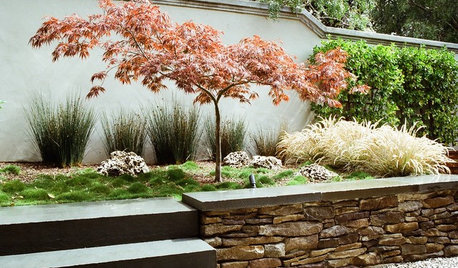HELP! Japanese maple yellowing leaves and dying
oldgromit
12 years ago
Featured Answer
Sort by:Oldest
Comments (14)
tapla (mid-Michigan, USDA z5b-6a)
12 years agopeapod13
12 years agoRelated Discussions
Help with dying Japanese Maple Shrub
Comments (9)its fall in my MI ... one on my JMs looks worse than that.. lol ... it will come back next spring.. at best... i would not expect much more now .... and actually ... i would prefer .... it not releaf this late in the year ... i probably would have put it another 2 or 3 feet from the house... you have given it no room for future growth ... [i am being an optimist ... lol ] you made the right decision on replanting .. and i presume you followed teh guide ... now all you have to decide.. is if you want to do it one more time.. lol .. all it needs.. is proper water.. its not hungry.. its stressed ... i wish you luck.. let us know how it works out ... ken ps: the best time to plant trees... is usually right after they lose their leaves ... its root growing season.. and its so much less stressful w/o the leaves ... just water properly ... so it really doesnt matter if you tree doesnt have leaves.. in fall .....See MoreHelp with Japanese Maple - Leaves dying
Comments (1)Did you put a broadleaf herbicide on that nice looking lawn? Mike...See MoreJapanese Maple looks like it is dying....please help!
Comments (1)Where are you located that your tree is in leaf now? And can you post photos of the problem? Are you growing it in a container? If so, how long has it been planted, what type of potting soil, how often do you water? Need more info to even attempt to diagnose a problem....See MoreNew spring japanese maple leaves are wilting/dying
Comments (6)I examined the tree again last night. Those wilting leaves are definitely dead now, though those few healthy branches still seem to be hanging on OK. We haven't had any late frosts persay - nothing that has affected any other plants/trees in the yard. I don't think the leaves were sun-scorched, as the tree survived quite well in this location all throughout the hot/sunny summer and early fall last year. Overwatering could be a possibility; we have had a lot of rain lately. Would overwatering only kill off some of the leaves/stress out part of the tree though? Another possibility...? The maple didn't really lose its leaves last fall and in the winter we had an ice storm. Ice stuck to the dead leaves, weighing the tree down; for half a day it was literall bent in half with its top branch tips and leaves touching the ground. When it melted, the tree popped right back up again but most of the branches were left slightly curved in the direction the tree was bent. Looking at the branches last night, it seemed that all of those that still remained curved had the dead leaves. Those with straight stems/branches had healthy looking leaves. Is it possible that the tree is suffering from some sort of delayed stress reaction to the ice storm? As mentioned before, it looked great with all the new buds and fresh leaves in early spring......See Morecalistoga_al ca 15 usda 9
12 years agopeapod13
12 years agoUser
12 years agopeapod13
12 years agooldgromit
12 years agopeapod13
12 years agooklahomarose
12 years agopeapod13
12 years agopeapod13
12 years agooldgromit
12 years agopeapod13
12 years ago
Related Stories

TREES11 Japanese Maples for Breathtaking Color and Form
With such a wide range to choose from, there’s a beautiful Japanese maple to suit almost any setting
Full Story
GARDENING GUIDES12 Japanese Maples for a Sunny Garden
The right maple in the right place shines in hot summer sun
Full Story
GARDENING GUIDES13 Japanese Maples for Shade
A surprising variety of these understory trees is waiting to make a statement in your shade garden
Full Story
GARDENING AND LANDSCAPINGGreat Design Tree: Japanese Maple
Lacy form and fiery fall color make Japanese maple a welcome tree for garden or patio
Full Story
TREESGreat Design Plant: Coral Bark Japanese Maple, a Winter Standout
Go for garden gusto during the chilly season with the fiery red stems of this unusual Japanese maple
Full Story
MOST POPULAR7 Ways to Design Your Kitchen to Help You Lose Weight
In his new book, Slim by Design, eating-behavior expert Brian Wansink shows us how to get our kitchens working better
Full Story
EXTERIORSHelp! What Color Should I Paint My House Exterior?
Real homeowners get real help in choosing paint palettes. Bonus: 3 tips for everyone on picking exterior colors
Full Story
GARDENING GUIDES8 Unthirsty Plants Help You Save Water in Style
Spend less effort and money on your landscape with drought-tolerant and native plants that liven up your yard
Full Story
FALL GARDENING5 Ways to Put Fall Leaves to Work in Your Garden
Improve your soil and yard the organic way with a valuable garden booster that grows on trees
Full Story
REMODELING GUIDESInterior Brick: Paint it or Leave It?
Here's how to know if covering that brick is a sin or solution
Full Story


oldgromitOriginal Author